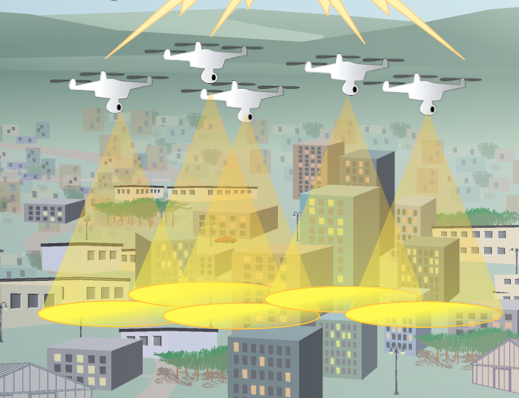Distributed Dynamics Research Projects
Potential Future Projects
Distributed ISR Systems for Wide Area Coverage (2015)Lincoln Laboratory - Ben Smith and Chris Anderson Many of the currently researched PED systems developed for wide-area missions revolve around the centralized collection of all data on a single, large platform. Recent advances in the field of unmanned aerial systems (UAS) have been rapidly enhancing the capabilities of small aerial platforms that will soon allow UAS's to be deployed in groups to address more traditional wide area ISR tasks. This program will begin to address the gap between the current state-of-the-art PED systems for single, large platform, wide area sensors and the need for PED systems that can be applied to the future use of distributed wide area coverage using a number of small UAS's. In particular, the program will focus on the development of tools that can take imagery/video data collected from a distributed set of sensors and efficiently process these data so that a coherent overall picture of the coverage area can be attained. |
|
Toward Dynamic Command and Control (2015)Lincoln Laboratory - Danelle Shah Many military, humanitarian, and emergency response operations involve large distributed teams that must coordinate to plan and execute complex tasks. As the size, tempo and uncertainty of such operations increase, effective means of command and control (C2) become increasingly crucial for achieving mission success. Common static C2 architectures, e.g., centralized or hierarchical, can provide valuable structure and organization when the problem space is well-known and roles are clearly defined. However, in highly dynamic environments, adaptive C2 strategies may be required to appropriately react to evolving situations. Determining how to optimally employ human agents is key to achieving effective dynamic command and control. This program aims to develop quantitative methodologies for modeling, estimating (human) performance, and dynamically reconfiguring C2 strategies. |
|
Crowd Sensing: Humans as Sensors (2015)Lincoln Laboratory - Danelle Shah Humans within the general population are numerous, mobile, and rich sources of information. Exploiting volunteered human-centric data, collected either actively (e.g., Amazon Mechanical Turk) or passively (e.g., via smartphone apps or transit fare collection systems), can have impact on multiple applications, such as urban dynamics modeling, public health/safety, traffic and transportation management, etc. This program aims to develop models, algorithms, and systems to perform participatory sensing and exploit various kinds of human-centric data to address such problems of national and public interest. |



